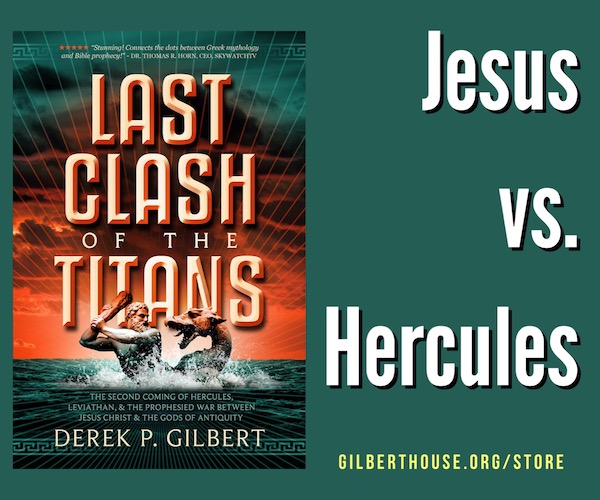As we’ve pointed out, the long war by the Fallen against their Creator is ultimately for control of God’s mount of assembly, Zion. That’s His prize jewel, and that’s why the enemy wants it:
Great is the LORD and greatly to be praised
Psalm 48:1–2, ESV
in the city of our God!
His holy mountain, beautiful in elevation,
is the joy of all the earth,
Mount Zion, in the far north,
the city of the great King.
So you shall know that I am the LORD your God,
Joel 3:17, ESV
who dwells in Zion, my holy mountain.
And Jerusalem shall be holy,
and strangers shall never again pass through it.
For the LORD has chosen Zion;
Psalm 132:13–14, ESV
he has desired it for his dwelling place:
“This is my resting place forever;
here I will dwell, for I have desired it.”
Plenty of other verses support this idea, but you get the point. God’s holy mountain, His mount of assembly, is Zion—the Temple Mount in Jerusalem.
Yes, we know some believe Solomon’s Temple was in the City of David and not on the Temple Mount. We respectfully disagree. The evidence, including recent archaeological excavations in the City of David at the alternate location proposed for the Temple, does not support that theory.[1] The most obvious bit of evidence is the testimony of first-century Jewish historian Josephus, who wrote that the platform supporting the Temple measured five hundred cubits square. That’s wider than the City of David, which sits on a small, narrow hill south of the Temple Mount. Had the platform been there, the Temple would have extended out over the Kidron Valley.[2]
Placing the great and terrible battle called Armageddon there makes sense from a strategic standpoint. It’s the home of the prize, the mount of assembly. Besides, other apocalyptic prophecies in the Old Testament point to Jerusalem at the site of the final showdown between good and evil.
The oracle of the word of the LORD concerning Israel: Thus declares the LORD, who stretched out the heavens and founded the earth and formed the spirit of man within him: “Behold, I am about to make Jerusalem a cup of staggering to all the surrounding peoples. The siege of Jerusalem will also be against Judah. On that day I will make Jerusalem a heavy stone for all the peoples. All who lift it will surely hurt themselves. And all the nations of the earth will gather against it.…
And on that day I will seek to destroy all the nations that come against Jerusalem.
Zechariah 12:1–3, 9, ESV (emphasis added)
For I will gather all the nations against Jerusalem to battle, and the city shall be taken and the houses plundered and the women raped. Half of the city shall go out into exile, but the rest of the people shall not be cut off from the city. Then the LORD will go out and fight against those nations as when he fights on a day of battle. On that day his feet shall stand on the Mount of Olives that lies before Jerusalem on the east, and the Mount of Olives shall be split in two from east to west by a very wide valley, so that one half of the Mount shall move northward, and the other half southward.
Zechariah 14:2–4, ESV (emphasis added)
For behold, in those days and at that time, when I restore the fortunes of Judah and Jerusalem, I will gather all the nations and bring them down to the Valley of Jehoshaphat. And I will enter into judgment with them there, on behalf of my people and my heritage Israel, because they have scattered them among the nations and have divided up my land.
Joel 3:1–2, ESV (emphasis added)
The phrase “on that day” refers to the Day of Yahweh, or Day of the Lord, the time of God’s judgment against a rebellious and unbelieving world. Zechariah and Joel saw the same final battle as Ezekiel. God will personally intervene to destroy the army assembled against Israel. That’s the Second Coming, the return of Messiah.
When He arrives, the Mount of Olives splits in two, creating “a very wide valley.” This is probably the Valley of Jehoshaphat, a location that doesn’t exist today on any known map. It’s not a reference to the king of Judah during the days of Ahab; “Jehoshaphat” means “Yahweh will judge,”[3] which obviously is not a coincidence.
If you’ve studied end-times prophecy at all, you’ve probably read or been taught that Armageddon will be fought at Megiddo, not Jerusalem. That’s understandable. It’s a popular teaching, but it’s based on the difficulty of transliterating from Hebrew to Greek to English.
We’ve been taught that Armageddon is a compound name based on the Hebrew har magedōn, where the -on suffix indicates a place name.[4] In fact, several English translations, such as the NASB, NRSV, and ASV, render the name either “Harmagedon” or “Har-Magedon.” Respected prophecy teachers, including Chuck Missler, Dwight Pentecost, John Walvoord, and Arnold Fruchtenbaum, identify har magedōn as the Mount of Megiddo, and place it near the city of Megiddo in the Valley of Jezreel.[5]
This is logical from a military standpoint. Megiddo overlooks the broad, fertile valley that connects the Jordan River to the Mediterranean, and it guards a key pass through the Carmel mountain range. Several decisive battles were fought at or near Megiddo: In the fifteenth century BC, probably not long before the Exodus, Pharaoh Thutmose III defeated a confederation of Canaanite city-states there. In 609 BC, the Judean king Josiah was killed in battle at Megiddo against Pharaoh Necho, who was leading an Egyptian army north to fight with his Assyrian ally against Babylon. Apparently, Josiah and his advisers thought it was better to side with the rising power, Babylon. Sadly, things went badly for the last good king of Judah and Josiah was killed in the battle by an Egyptian archer. Worse, despite Josiah’s effort, less than twenty-five years later, Nebuchadnezzar led an army from Babylon to sack Jerusalem and destroy the Temple. Some gratitude.
But there are problems with placing Armageddon at Megiddo. First of all, there’s no mountain there. The ancient site of Megiddo is elevated above the plain, yes, but it’s not a mountain, it’s a tell—a mound created when people build and rebuild a settlement over centuries on the same spot. Second, it’s unlikely God would descend on the Mount of Olives when the Antichrist and the armies of the world are at Megiddo, more than fifty miles away.
The problem of identification comes from the difficulty in transliterating from Hebrew to Greek. In 1938, scholar Charles C. Torrey proposed a solution: Armageddon is based not on har magedōn, the name of a nonexistent mountain, but on a phrase we’ve encountered before, har môʿēd (“mount of assembly”). Remember Isaiah 14?
How you are fallen from heaven,
Isaiah 14:12–13, ESV (emphasis added)
O Day Star, son of Dawn!
How you are cut down to the ground,
you who laid the nations low!
You said in your heart,
“I will ascend to heaven;
above the stars of God
I will set my throne on high;
I will sit on the mount of assembly [har môʿēd]
in the far reaches of the north” [yarkete tsaphon, Mount Zaphon].
Torrey’s argument was that scholars who weren’t expert in both Greek and Hebrew had missed the fact that the Hebrew character ayin, which is represented in English by the character ʿ (a reverse apostrophe) because we don’t have the sound or the letter in our alphabet, was represented in Greek by the letter gamma, because there is no Greek sound or letter that corresponds to ayin, either.[6] So, the Hebrew mem-ayin-daleth (M-ʿ-D) was transliterated by John into the closest Greek approximation, mem-gimel-daleth (M-G-D).[7] Thus, har môʿēd became har magedōn, and the battle of Armageddon was transplanted from Mount Zion in Jerusalem to a place of no supernatural significance where no mountain exists.
Make no mistake. The spiritual war is for control of the har môʿēd—Armageddon. The last great battle of history will be fought at Zion—the Temple Mount in Jerusalem, God’s mount of assembly.
[1] See, for example, www.TempleMountLocation.com.
[2] Franz, G. (2015). “Eight Reasons Why the Temples of King Solomon and Herod the Great Were NOT Over the Gihon Spring in the City of David.” Life and Land Seminars, http://www.lifeandland.org/2015/11/cornuke-temple/, retrieved 3/30/18.
[3] Barry, J. D., Mangum, D., Brown, D. R., Heiser, M. S., Custis, M., Ritzema, E., … Bomar, D. (2012, 2016). Faithlife Study Bible (Joe 3:2). (Bellingham, WA: Lexham Press).
[4] Kline, M. (1996). “Har Magedon: The End of the Millennium.” Journal of the Evangelical Theological Society39, 2.I, p. 208.
[5] Putnam, C. (2011). “Armageddon OT Background to the Battle for the Cosmic Mountain.” http://www.logosapologia.org/armageddon-ot-background-to-the-battle-for-the-cosmic-mountain-2/, retrieved 3/31/18.
[6] Heiser, M. (2015). Op. cit., p. 371.
[7] Ibid.

